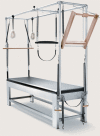Pilates: what is it? Should it be used in rehabilitation?
- PMID: 23016028
- PMCID: PMC3445206
- DOI: 10.1177/1941738111410285
Pilates: what is it? Should it be used in rehabilitation?
Abstract
Context: The interest and popularity of Pilates is increasing worldwide. In addition to being used in fitness programs, it is being used in some rehabilitation programs.
Evidence acquisition: This review summarizes level III evidence from 1995 to 2009 obtained from PubMed (MEDLINE), CINAHL, and the Internet. Meta-analyses, systematic reviews, randomized controlled trials, and controlled trials published in peer-reviewed journals were retrieved for appraisal. The keywords searched were Pilates and core stabilization.
Results: Ninety articles were identified in MEDLINE and CINAHL; 9 articles satisfied the inclusion criteria for level III evidence.
Conclusion: There is a scientific basis for the effectiveness of Pilates exercise, with limited evidence to support it as a rehabilitative intervention.
Keywords: Pilates; core strengthening; rehabilitation.
Figures
















References
-
- Allison GT, Morris SL, Lay B. Feedforward responses of transversus abdominis are directionally specific and act asymmetrically: implications for core stability theories. J Orthop Sports Phys Ther. 2008;38:228-237 - PubMed
-
- Akuthota V, Nadler SF. Core strengthening. Arch Phys Med Rehabil. 2004;85(3):S86-S92 - PubMed
-
- Arokoski JP, Valta T, Airaksinen O, et al. Back and abdominal muscle function during stabilization exercises. Arch Phys Med Rehabil. 2001;82:1089-1098 - PubMed
-
- Barnett F, Gilleard W. The use of lumbar stabilization techniques during the performance of abdominal strengthening exercise variations. J Sports Med Phys Fitness. 2005;45:193-201 - PubMed
-
- Bergmark A. Stability of the lumbar spine: a study in mechanical engineering. Acta Orthop Scand. 1989;230:20-24 - PubMed
LinkOut - more resources
Full Text Sources
Medical

